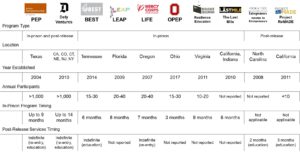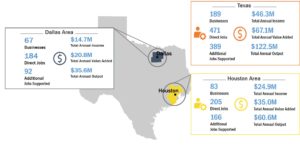Back

Blog
Innovative Prison Entrepreneurship Program is Creating Wealth & Reducing Recidivism Among Formerly Incarcerated
Written by Austin Nijhuis and Peter Eberhardt
In 2016, over 626,000 individuals in the U.S. were released from state or federal prisons. Often released with nothing more than a bus ticket and a check for less than $200, the formerly incarcerated face serious economic challenges. They struggle securing necessities such as housing and transportation, let alone finding employment. Employers are often unwilling to hire individuals with criminal records and the jobs that are available often pay them lower wages. Given these challenges, it is perhaps not surprising that 36 percent return to prison within three years of release.
In response, a growing number of prison entrepreneurship programs are supporting the formerly incarcerated in starting businesses that offer pathways to building wealth and achieving greater economic mobility. These programs provide entrepreneurship education and training to individuals either in prison or after they are released. As of 2018, there were at least ten prison entrepreneurship programs operating in the U.S.
Comparison of Prison Entrepreneurship Programs in the U.S.

These prison entrepreneurship programs, which are an alternative to traditional ex-offender workforce development and re-entry programs, have the potential to create economic opportunity for individuals, reduce recidivism, and offer significant fiscal savings and economic impact. While recent research has found that inmates who participate in any kind of prison education program are less likely to return to prison, and are more likely to obtain employment than other inmates, little research has analyzed the impact of prison entrepreneurship programs. The effectiveness of prison entrepreneurship programs, their ability to reduce recidivism, and their economic and fiscal impact is not fully understood.
The Prison Entrepreneurship Program: A Promising Approach to Successful Re-Entry
To help fill this gap in information, the Initiative for a Competitive Inner City, with support from JPMorgan Chase & Co., recently completed a robust evaluation of the Prison Entrepreneurship Program (PEP) in Texas. ICIC’s evaluation considered (1) PEP’s impact on increasing economic opportunity and reducing recidivism for its graduates, (2) its effectiveness as an entrepreneurship program, and (3) the economic and fiscal impact of the program in Texas. We utilized survey data collected by PEP in 2017, interviews with PEP graduates conducted by ICIC in 2018, and other data from PEP and public sources.
Founded in 2004, PEP seeks to reduce recidivism and increase economic opportunity for incarcerated individuals through entrepreneurship training and re-entry services. PEP’s mission is to unite executives and inmates through entrepreneurial passion and servant leadership to transform lives, restore families and rebuild communities. PEP envisions being an inspired national leader in prisoner re-entry. As Bryan Kelley, PEP’s CEO (Chief Empowerment Officer) and a 2014 PEP graduate explains, “We strive to empower our men to move from being tax consumers to taxpayers; from gang leaders to servant leaders; and from felons to real fathers and philanthropists.”
PEP is one of the oldest, largest and most comprehensive prison entrepreneurship programs in the U.S. and has been influential in the formation and structure of similar programs across the country. PEP offers both in-prison curriculum and post-release services to over 1,000 individuals annually across four prison units in Texas.
PEP Application Process

Its in-prison program includes a three-month leadership and character development course as well as a six-month “mini-MBA” component where participants develop business plans, work with executive volunteers, and complete a college-level entrepreneurship curriculum. The in-prison program culminates in a Pitch Day, where participants pitch their business plans to panels of judges through several competitive rounds. The day concludes with a graduation ceremony, where participants receive a certificate of entrepreneurship from Baylor University.
After release, PEP continues to offer re-entry services to its graduates, including family liaisons, transitional housing and re-entry services, and Entrepreneurship School (eSchool), an ongoing education program that provides weekly workshops on business and life skills. These comprehensive post-release services are offered to PEP graduates indefinitely.
Creating Economic Opportunity for the Formerly Incarcerated
Since its inception in 2004, 2,180 individuals have graduated from PEP. Between 2004 and January 2018, PEP graduates have established 361 businesses. Fifty-seven percent of the businesses remain open today, which is higher than the average rate of business survival for Texas during the same time (53 percent). In total, nearly one in four released PEP graduates have started a business.
Of the PEP graduates who do not start businesses, most are gainfully employed. In 2017, 67 percent of PEP graduates surveyed were employed, 28 percent were entrepreneurs actively running a business and just 5 percent were unemployed.
Both PEP graduate entrepreneurs and PEP graduate employees (those employed elsewhere) earn significantly higher wages than the Texas minimum wage. The average wage of PEP graduate employees surveyed was $17.17 per hour, 137 percent greater than the minimum wage in Texas. The average wage of PEP graduate entrepreneurs surveyed was $21.19 per hour, 192 percent greater than minimum wage. The average income of PEP graduate entrepreneurs was 276 percent greater than the average hourly earnings for formerly incarcerated men in Texas.
As one graduate entrepreneur interviewed by ICIC explained, entrepreneurship was the only pathway to financial security: “At the first place I worked at out of prison, I was told that the job paid $13 per hour, but with a felony only $10. I didn’t want to start a business for a few years, but decided I had to because it was the only way to financially survive. I’ve been able to buy a house and truck—I wouldn’t be able to afford these otherwise.”
Reducing Recidivism
Incarceration and recidivism are significant challenges in Texas, especially for men. Over 125,000 men were incarcerated in Texas in 2016 and 23 percent of males released from a state prison in Texas will return to prison within three years of release. In comparison, only seven percent of PEP graduates return to prison within three years of release.
PEP’s curriculum and leadership training is designed to help students develop re-entry plans and build hope, optimism and resilience. For many graduate entrepreneurs ICIC interviewed, they felt that the lifestyle changes they made while in prison were the biggest factors in reducing their chances of going back to prison.
As one graduate entrepreneur interviewed by ICIC explained, “Prison is detrimental to the extent that it does not require you to have a job or get through education. If it was up to me, everyone would have to go through PEP before coming home. It forces you to think about where you are in life and come up with a plan for yourself. To have a program where you can get away from prison and have people invest in you and empower you, it gives you an opportunity to have a voice. When you couple that with the networking side, the social side, it empowers people to take off the years of fear that prison gives you. I don’t have enough good things to say about the program.”
PEP Drives Growth in Texas
The economic impact of all active PEP businesses in Texas was measured using IMPLAN in partnership with the UMass Donahue Institute. There are currently 189 active PEP businesses in Texas. Combined, it is estimated that these businesses employ 471 people, support an additional 389 indirect and induced jobs and generate $122.5 million in total annual output. The majority of these businesses are located in the Houston and Dallas areas.
The Economic Impact of PEP Businesses

Note: Additional jobs supported are indirect and induced jobs. Total annual income, annual revenue, and annual output include direct, indirect and induced impacts.
Source: IMPLAN, UMass Donahue Institute analysis.
In 2017, 357 PEP graduates were released from prison. The estimated fiscal impact per released graduate after one year was $12,053 in cost savings to the state and federal government. PEP’s annual program costs $2.7 million, which is fully funded by private sources, including corporate, philanthropic and individual donations. The one-year investment of $7,591 per released graduate by PEP donors results in a one-year “Return on Investment” of 159 percent. After five years, the “ROI” increases to 794 percent.
Policy Implications
PEP has demonstrated that entrepreneurship works to reduce recidivism and should be considered as an alternative to traditional ex-offender workforce development and re-entry programs. Businesses created by PEP graduate entrepreneurs have a significant impact on their community, and many operate in areas with limited economic opportunities and create jobs for formerly incarcerated individuals. It is a program worth replicating in other states dealing with high incarceration and recidivism rates.
